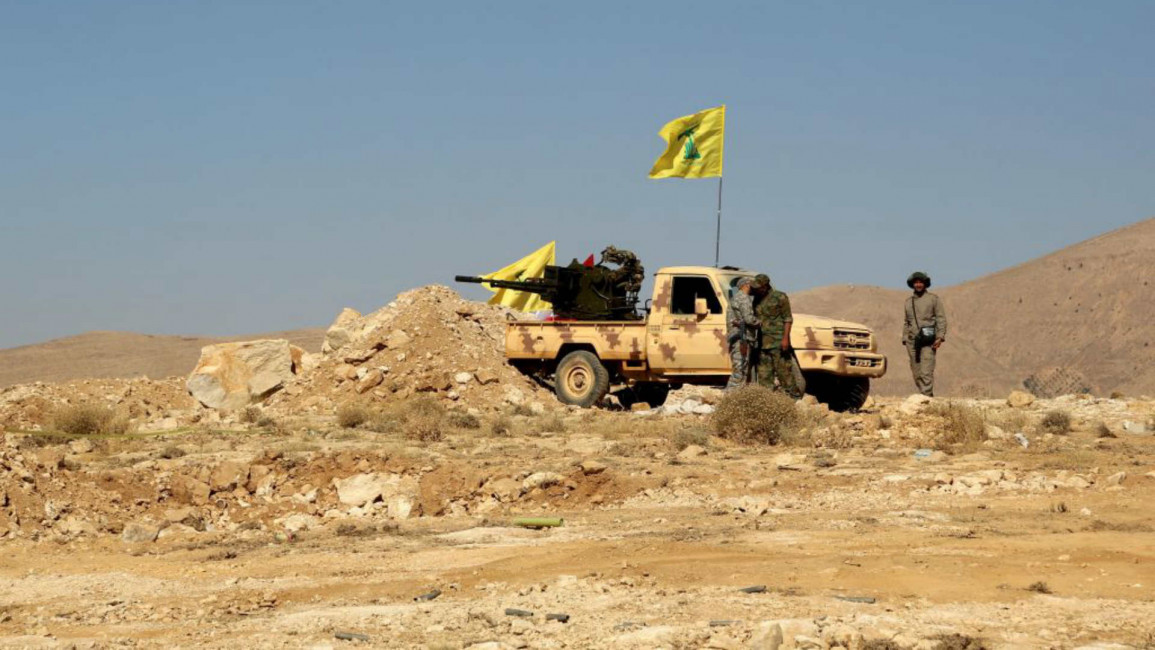
Hizballah's new alliances on show in calculated media stunt
This came in the wake of US president Donald Trump's recognition of Jerusalem as Israel's capital, and is telling of the organisation's regional and local strategy.
It is an astute media stunt on the part of the Lebanese organisation, sending the message that AHA, like Hizballah, is now part of a regional federative militia. It also allows Hizballah to show force without using it, being careful not to shake up the status quo on the Lebanese border, while it is engaged elsewhere in the region.
In a video leaked on Friday, Khazaali could be seen in south Lebanon at the Fatima Gate overlooking the Israeli areas of Metulla and Kiryat Shmona. "We here with Hizballah declare our total readiness to stand together with the Lebanese people and the Palestinian cause against Israeli occupation," Khazaali is heard saying in the video.
Khazaali was dressed in military fatigues when he declared his readiness to support "resistance fighters" and to come to the rescue of Palestinians and Jerusalem.
The images of Khazaali are an astute media stunt on the part of Hizballah.
The organisation has built its raison d'etre on fighting Israel, against which it fought a bloody insurgency, forcing the Israeli army to end their occupation of Lebanon in 2000.
Since then, the Party of God has argued it is the only force capable of fighting Israeli aggression in the absence of strong Lebanese military forces. Israel and Hizballah also fought a 33-day war in 2006, which came to an end under UN Security Council Resolution 1701 that called for disarmament of Hizballah, in the wake of withdrawal of the Israeli army from Lebanon. Yet since then, the organisation has significantly bolstered its capabilities , and its fighting force is now comparable to that of an Arab army.
 |
The Khazaali visit officialises close relations between the pro-Iran PMF and Hizballah |  |
In 2011, Hizballah turned its focus away from Israel to Syria, where it deployed thousands of fighters to prop up the regime of Bashar al-Assad - challenged by revolution - under the banner of fighting "terrorist takfiris".
Iraqi forces such as AHA and other pro-Iranian militias from PMF were also deployed there by Iran. Both Hizballah and pro-Iran PMU worked closely on the Syrian military theatre, fighting side by side in Aleppo, Deir az-Zour and elsewhere, while coordinating operations and battles. The organisation also sent several hundred experts to Mosul, Iraq during the battle on the Islamic State.
The Khazaali visit officialises close relations between the pro-Iran PMF and Hizballah, sending the message that Lebanese and Iraqi militias backed by Iran are no more mere allies in the new "Resistance" axis headed by Tehran, but members of its united regional expeditionary force.
For Hizballah, the visit served as a military stunt that did not require resorting to actual violence.
Read more: Hizballah's hubris is being reined in by an unpredictable Saudi regime
The visit of the leader of a foreign militia, funded and trained by the IRGC and labelled by the US as a terrorist, points to significant security gaps within the UN's mission in south Lebanon, where the Lebanese state and the UN are supposed to be the main actors, with Hizballah, in theory, militarily absent.
It also sends a direct and clear threat to Israel, which is increasingly uneasy of the organisation's growing capacity - acquired in Syria - to launch multi-pronged attacks and ground offensives.
 |
For Hizballah, the visit served as a military stunt that did not require resorting to actual violence |  |
Yet this visit also indirectly highlights the constraints faced by Hizballah at the Lebanese level.
As long as it is significantly deployed in Syria, the organisation will avoid destabilising the Lebanese southern front and the country's security situation.
After all, the organisation has been able to shift the balance of power in its home base, Lebanon, with its ally President Michel Aoun at the head of the state, and an amenable "consensus" government.
On 4 November, Prime Minister Hariri announced his resignation while visiting Saudi Arabia, accusing Iran and Hizballah of meddling in regional conflicts in violation of Lebanon's policy of non-intervention, before recanting on it two weeks later. It remains to be seen how his renewed pledge to of "disassociation" from regional conflicts may affect the Lebanese state's relations with Hizballah.
Opening a new front in southern Lebanon over Jerusalem is thus not in Hizaballah's calculations for now, as its war is elsewhere.
Mona Alami a non-resident fellow with the Atlantic council covering Middle East politics with a special interest in radical organizations.
Follow her on Twitter: @monaalami
Opinions expressed in this article remain those of the author and do not necessarily represent those of The New Arab, its editorial board or staff




